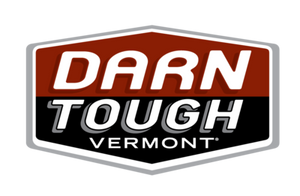How to Choose the Right Socks for Work

The Best Sock Testers
When you work for a sock company with a Lifetime Warranty, you research, design, and test according to who and what will push your socks to the limit. As part of my job in product development, I look for testers who not only wear our socks but live in them. Who puts socks on every day and needs them to perform?
Many folks assume that thru hikers or ultramarathoners are the pinnacle sock testers. While these badass men and women offer vital feedback that improves our socks, the ultimate sock testers in my book are the people who work hard on their feet, every day. The men and the women who need their gear and tools to work as hard as they do, day in and day out, in any and every condition.

I’m thinking of farmers, warehouse workers, loggers, ranchers, arborists, gardeners, welders, painters, roofers, line workers, postal employees, surveyors, electricians, plumbers, riggers, excavators… the list goes on and on.
In this post, I’ll be giving some pointers on how to choose the best socks for work, whatever job you have lined up.
What Kind of Work?
To pick the best socks for work, the first question to ask is, what kind of work are you doing?
At Darn Tough, we designed a line of socks for working on your feet, specifically for those who on their feet all day in all conditions, often while wearing work boots. The farmers, loggers, ranchers, welders, construction workers, and others. If this sounds like the work you do, keep reading. I’ll spend this post talking about socks for this type of work and how to choose the best one for you.

If your work looks more like days at the office, business clothing, or dress footwear, we still have work socks for you. You’ll want to check out our dress and casual socks in our Lifestyle sock line. We have great options in Lifestyle to pair with any shoe for work or occasions.
Work-Focused Features
Here’s the deal: you can have the best, most technical work boots or shoes in the world, but your feet are not going to be happy if you are wearing a crappy pair of socks. If you’ve checked out my past post on Choosing the Best Socks, then what you just read probably seems familiar. I reiterate it here because it is vital for those who are on their feet all day.
Another point I’ll echo: The best socks, the most comfortable socks for work, are the socks you do not notice. Socks that, once on, stay where you want them, wick moisture away, insulate as needed, and work as a singular system with your foot and footwear.

In celebration of industrious and productive people, we name our Work socks after individuals that embody the attitude and tenacity needed to get the job done. These include great figures like John Henry, Mary Fields, Mollie Beattie, Fred Tuttle, to name a few. We hope our socks live up to their names.
So what are some features you should not notice when choosing socks for work?
- Cushioned comfort
- Durability in high-wear zones
- Performance fit
- Temperature control (aka thermoregulation)
Cushioned Comfort
All Darn Tough Work socks feature terry loop Merino Wool cushioning for all day comfort and padding. Why? Because workers are often on their feet for hours or even days at a time.

Cushioning helps protect your feet from impact and potential hot spots within your work boots or other rigid footwear. Cushioning also means more Merino Wool, which aids in moisture wicking and temperature regulation. In our experience, cushioning means happier feet for longer.
When choosing a work sock, you can choose between Cushion and Full Cushion options, as well as a Full Cushion Toe option designed specifically for steel toe boots.
Cushion Socks
Cushion socks have terry loop cushioning underfoot, around the toe, and behind the heel in high-impact zones.
Additionally, in our Work Boot socks (John Henry, RTR, and Steely Boot), there is cushioning within the leg that acts as a lace guard.
Full Cushion Socks
For Full Cushion socks, the entire sock is knit with terry cushioning, including in the top of the foot.
There is one exception: right behind the Darn Tough logo on the toe, some Work socks feature a mesh zone to aid in venting (e.g. William Jarvis, Mary Fields, Paul Bunyan). That’s the one non-cushioned part.

These thick work socks add extra warmth and protection. They aren’t just for winter though; Full terry loops can be quite comfortable in summer too due to the thermoregulating properties of Merino Wool.
Full Cushion Toe for Steel Toe Boots
The Steely socks feature extended Toe Box cushioning for extra comfort and a better fit in safety-toed footwear.
The rigid toes in composite or steel-toed boots limit mobility and breathability, creating more opportunities for your feet to be uncomfortable. The Full Cushion Toe in our Steely socks helps regulate temperature and protect your toes when wearing hard-toed boots.

Not wearing steel or composite-toed boots? Not a problem. My brother wears our steel toe boot socks in winter for warmth in normal leather boots and my wife wears them around the house as slippers because she gets cold toes (even in summer).
Enhanced Durability in High-Wear Zones
Merino Wool is naturally tough. Additionally, we knit our socks with fine gauge yarns in a high-density knit. High density knitting creates a better fitting and more durable socks.
In addition to the high quality materials and compact knit, we add nylon reinforcement underfoot, behind the heel, and in the toe where socks wear out the most.

Between cushioning, knit structure, and added durability, these socks are built to perform a lifetime.
Performance Fit
We knit Darn Tough work socks with a performance fit to keep material from bunching and slipping, and an elastic-supported leg and foot arch so your socks stay right where you want them, all day long.
As you move around your workplace or jobsite, you want your feet, socks, and boots to work as a singular system with as little movement between them as possible. Slipping and bunching can cause blisters, hot spots, or other discomfort. A well-fitting sock eliminates foot fatigue when you’re on your feet all day.
Temperature Control — Merino Wool
We make every Work Sock with three simple ingredients: Merino Wool for performance, Nylon for durability, and Spandex for fit.
Merino Wool is naturally thermoregulating, moisture wicking, and odor resistant. Many people associate wool with itchiness, bulkiness, and heat, but it does not have to be this way! In fact, Merino Wool is the secret to how our socks keep your feet the perfect temperature and sweat-free.
With high quality Merino Wool, your feet can stay warm in cold weather and cool in hot weather, even in the same pair of socks. Merino Wool holds or releases heat depending on what your body is doing, all through microscopic insulation pockets within the fiber. Merino Wool also wicks moisture away from your skin, helping keep your feet comfortable, even in non-breathable footwear like rubber boots.

Oh, and the chemical structure of wool prevents bacterial build-up too, which will beat the stink. Many synthetic fibers claim to have properties like Merino. While some do, they only can mimic, but not fully replicate, what sheep have been doing for 10,000 years. All this is to say, these ain’t your granddad’s old wool work socks!
Check out this more in-depth info on Merino Wool science here.
Pairing Work Socks with Boots — Height & Weight
As I mentioned above, you can have the best fitting, most technical footwear for the job you’re doing but they are not going to perform to their fullest without good fitting, high-quality socks.
Up to this point, I’ve been looking at features you want in every Work sock. Next, let’s look at choosing the right weight and height. The right choice depends on the work boots or shoes you’re wearing and the conditions you’re working in. Let’s get into it.
Height
The height of your footwear dictates the sock height you’ll wear. For the best shoe-sock pairing, we recommend that socks for work come up at least to the top of your boot or shoe, if not higher, so you have full coverage to reduce friction and hot spots.
Some people want as little sock as possible poking out of their boots, while others want sock coverage above their footwear. If you’re wearing shorter work boots or shoes, you might still pick a tall sock based on other factors such as warmth or protection from dirt and debris. Or maybe you’re like me and like having your ankles covered, regardless of activity.
Darn Tough Work socks come in 4 heights – Quarter, Micro Crew, Boot, and Over-The-Calf.
- Quarter socks come up about 5.5 inches above your heel. These are great for ankle or “mid” lowcut work shoes or boots.

- Micro Crews pair nicely with a 6 or 8-inch boot.
- Boot sock height has you covered in 10-inch work boots.

- Over the Calf socks work in anything from the knee down, such as logging boots, rubber boots, or cowgirl and cowboy boots.
Weight
We knit most Darn Tough Work socks as Midweight socks. The exceptions to this are the Westerner, which is a specialized Lightweight work sock designed to pair with cowgirl and cowboy boots, and the Emma Claire and Stanley K socks, which are specially made as super-breathable, lightweight options to wear with rubber boots (more on our Lightweight sock options below).
All Purpose Midweight
Midweight is the sweet spot for year-round comfort. Chances are this is the best weight for you. Merino Wool socks are moisture wicking and thermoregulating, so your feet should stay cool in hot weather and warm in cold weather. The Midweight yarn offers insulation for impact on feet, while also wicking away sweat for all day comfort.

To be honest, I have extra sweaty feet. Wearing thicker socks seems contradictory to prevent sweat, but having more performance fiber can help keep my feet comfortable. If you’re wearing leather or rubber boots that don’t breathe well, the moisture has nowhere to go except out the top of your boot. Wearing a sock with more wool to pull moisture away from the foot and channel it out can help manage that moisture.
Lightweight: Westerner
The Westerner is a great sock for ranchers, cowboys and cowgirls, cowhands, or anyone else wearing western boots. Darn Tough was approached years ago to make a Lightweight sock to pair with western boots, and this one gets the job done.

The Westerner's Over-the-Calf height will keep your legs covered in all boots and keep your feet and legs cool by wicking away moisture in the heat. Think of a high-performance, Merino Wool tube sock.
Lightweight: Emma Claire and Stanley K
The Women's Emma Claire and Men's Stanley K socks originated with the challenge of creating super-breathable, warm-weather Work socks for footwear that tends to trap moisture.
Many workers need a lightweight, meshed, and protective sock. The lack of breathability in rubber boots — worn by farmers, deckhands, sanitation workers, gardeners, and many others — became the technical challenge to overcome. We figured that if a sock can breathe in rubber boots, it can breathe in anything.

Developed with Alaska's Salmon Sisters, we had the ultimate testers to help us design bullet-proof, comfortable, and ultra-breathable socks for long days in wet conditions.
These socks have it all:
- Boot height — tall enough to protect against boot collars rubbing your legs, without being too bulky or hot.
- Targeted mesh in the leg and on the top of the foot to aid Merino Wool's wicking properties to channel moisture away from the body.
- Increased durability and cushioning up the heel and around the ankle, as well as our Extended Protective Toe Box to protect from impact and keep your feet comfortable all day.
Can I Wear Non-Work Socks for Work?
So what’s the difference between Darn Tough Work socks and socks in comparable weights and heights in other categories?
In the end, we design socks for specific purposes. This means there are differences, some major and some minor, between categories to best fit with the intended footwear.
Work socks are knit mostly in Midweight yarns to best fit with the footwear required for the task – generally leather work boots, rubber boots, and steel-toed boots. Work socks have cushioning underfoot, as the wearers are typically on their feet for hours or days at a time. The durability-enforced zones and mesh placement fit with work boots.
This all said, if you like the look or function of one of our Hiking socks, go for it. It’s designed for trekking thousands of miles in hiking boots, so it will hold up in work boots too. Similarly, given the many conditions our armed forces may face, our Tactical socks make amazing work socks.
Can’t wear wool? Check out some Coolmax options in the Hiking and Running categories.
Need a Lightweight sock at Boot height? Check out options in Hunting or Hiking.
Want to answer a few simple questions to get some sock recommendations? Try our sock matcher.
Before we developed the Emma Claire and Stanley K, I knew a few workers who swore by some of our Snow socks when wearing rubber boots. They may not be designed specifically for Work, but we guarantee all our socks to be Darn Tough.
It's worth saying one last time though: our Work socks are specifically built for long days on your feet. Montana Lineman Dustin Maier knows what that's like, and he explains the importance of choosing the right work socks when you're not sure how long your "day" is going to be.
About the Author
Owen (VanGrizzle on the trail) works in Product Design and Development at Darn Tough. He's worked for the company since 2016, but even before he was hired, Darn Tough socks were the only socks he would wear. He's a resident sock tester, having thru hiked the Appalachian Trail in 2017 and Vermont’s own Long Trail twice.







